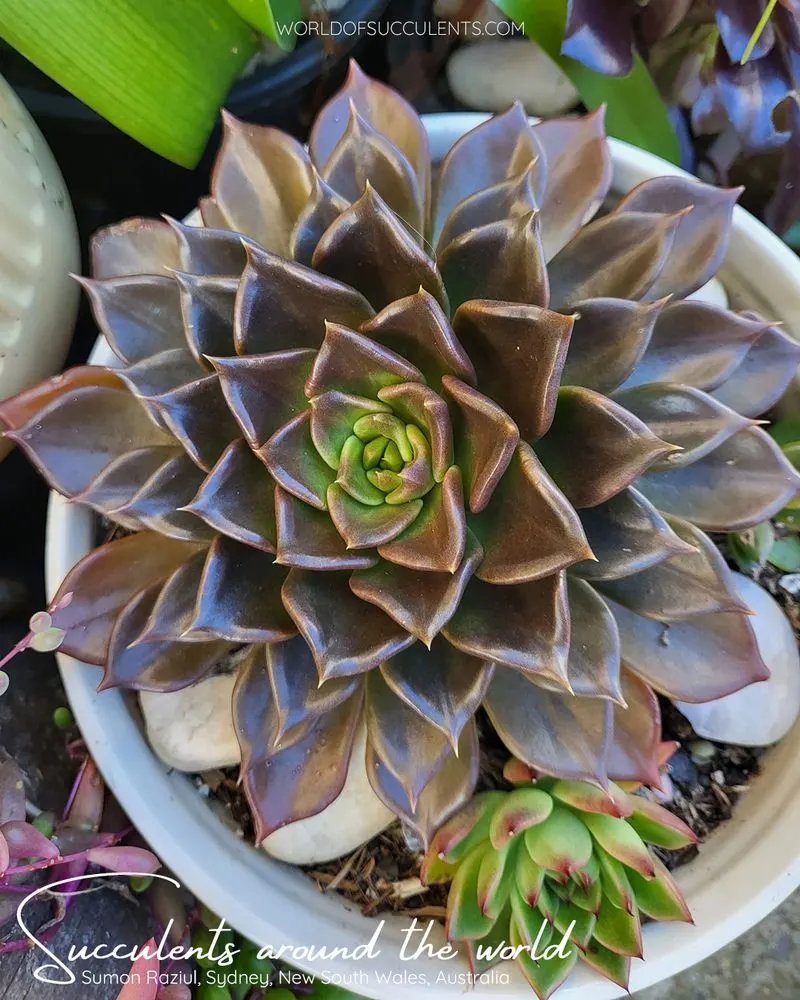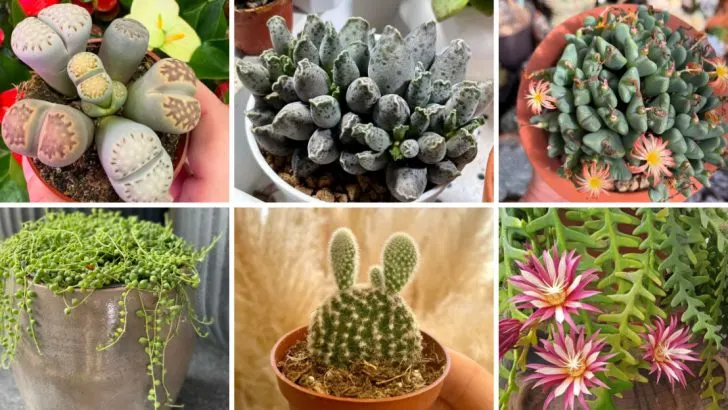Succulents are adored for their striking shapes, low-maintenance nature, and endless variety.
While common varieties like jade plants and echeverias are staples in many collections, there’s a world of rare and unique succulents that take their beauty to a whole new level.
In this list, we’ll showcase 14 extraordinary succulents that every plant enthusiast needs to see.
From unusual colors to fascinating textures, these rare gems are perfect for adding a touch of the extraordinary to your indoor or outdoor garden.
Living Stone (Lithops)

Lithops resemble small stones or pebbles, blending seamlessly into their natural surroundings. These fascinating plants are native to southern Africa, where their stone-like appearance serves as camouflage from herbivores.
Lithops grow in clusters, and each plant consists of a pair of thick, fleshy leaves that store water. These leaves split to reveal delicate flowers, usually white or yellow, during blooming season.
Ideal for window sills, they require minimal watering, making them perfect for busy plant lovers. Observing lithops thrive can be a rewarding experience, especially when witnessing their unique blooming process.
Plover Eggs (Adromischus cooperi)

Adromischus cooperi, commonly known as Plover Eggs, showcases thick, fleshy leaves adorned with unique purple spots.
These spots resemble the speckled appearance of bird eggs, hence the nickname. Native to South Africa, this succulent thrives in well-draining soil and bright, indirect sunlight. The compact growth habit makes it an excellent choice for small spaces or windowsills.
Watering should be minimal, as overwatering can lead to root rot. Its charming and unusual appearance makes it a conversation starter, offering a touch of nature’s artistry in any collection.
Baby Toes (Fenestraria rhopalophylla)

Fenestraria rhopalophylla, affectionately known as Baby Toes, features cylindrical leaves that resemble tiny toes peeking out of sandy soil. This unique succulent hails from the arid regions of Namibia and South Africa, adapting to diverse climates with ease.
The translucent tips of the leaves allow sunlight to penetrate, aiding in photosynthesis. Baby Toes prefer well-draining soil and limited watering. Over time, they may produce small, daisy-like flowers. Their quirky appearance and resilience make them a delightful addition to any plant collection, sparking joy with their playful form.
String of Pearls (Senecio rowleyanus)

Senecio rowleyanus, known as String of Pearls, enchants with its cascading stems adorned with spherical leaves resembling delicate pearls. This charming succulent is perfect for hanging baskets, where its long tendrils create a dramatic effect.
Native to the drier regions of Southwest Africa, it thrives in bright indirect light and requires minimal watering. The plant’s unique shape adds elegance to any space, and its growth is a joy to watch. Providing the right balance of light and water ensures a thriving display, making it an excellent choice for both beginners and seasoned gardeners.
Zigzag Cactus (Selenicereus anthonyanus)

Selenicereus anthonyanus, commonly known as the Zigzag Cactus, captivates with its uniquely shaped leaves that mimic a zigzag pattern.
This vibrant cactus originates from the rainforests of Mexico, where it grows as an epiphyte. Its ornamental leaves make it suitable for both hanging and tabletop displays. Preferring bright indirect light, this cactus requires well-drained soil and moderate watering.
During its blooming season, the Zigzag Cactus can produce large, fragrant flowers that add to its allure. Its distinct form and vibrant growth make it a standout addition to any plant enthusiast’s collection.
Bunny Ear Cactus (Opuntia microdasys)

Opuntia microdasys, endearingly known as the Bunny Ear Cactus, is characterized by its pad-like segments and tiny, soft spines.
This cactus brings a playful touch to any plant collection with its charming resemblance to bunny ears. Native to Mexico, it thrives in well-draining soil and requires full sunlight to flourish.
While it needs infrequent watering, the Bunny Ear Cactus is surprisingly resilient, adapting well to various conditions. Whether placed on a windowsill or incorporated into a desert-themed garden, its whimsical structure adds character without demanding much care.
Echeveria ‘Black Prince’

Echeveria ‘Black Prince’ offers a dramatic touch with its dark, almost black leaves forming a tight rosette. This succulent is a showstopper in any collection, drawing attention with its striking color.
Originating from Mexico, it prefers bright light to maintain its deep hue and should be watered sparingly. The ‘Black Prince’ is resilient, tolerating neglect while maintaining its allure.
Whether as a standalone piece or part of an arrangement, its bold presence enhances any setting. Its captivating color and form make it a favorite for those seeking a unique and low-maintenance plant.
Panda Plant (Kalanchoe tomentosa)

Kalanchoe tomentosa, or Panda Plant, features fuzzy, silvery leaves with endearing brown edges. The soft, velvety texture of the leaves invites touch and adds a tactile element to plant collections.
Native to Madagascar, this succulent thrives in bright, indirect sunlight and requires well-draining soil. Minimal watering is needed, making it suitable for those who may forget a watering schedule.
Its unique appearance and texture make it a delightful addition to any space, bringing a sense of comfort and intrigue. The Panda Plant enchants with its resilience and decorative appeal.
Crinkle Leaf Plant (Adromischus cristatus)

Adromischus cristatus, or Crinkle Leaf Plant, boasts distinctive crinkled leaves that add visual interest and texture.
This compact succulent is native to South Africa and thrives in dry climates. Its unusual foliage creates a striking display, whether showcased on a windowsill or as part of a succulent arrangement. The Crinkle Leaf Plant prefers bright light and minimal watering, ensuring its longevity with little effort.
Each leaf’s unique texture captures attention, inviting curious glances and admiration. Its compact size and intriguing appearance make it perfect for small spaces or as a conversation piece.
Haworthia ‘White Ghost’

Haworthia ‘White Ghost’ enchants with its ghostly pale leaves forming a tight rosette. This distinctive succulent stands out with its almost translucent appearance, offering a subtle elegance. Native to South Africa, it thrives in well-draining soil and bright, indirect sunlight.
Minimal watering is needed, making it ideal for those seeking a low-maintenance plant. The ‘White Ghost’ is a graceful addition to any collection, captivating with its unique coloration and form. Its ethereal beauty adds a touch of serenity, making it a perfect accent piece in modern interiors.
Fairy Castle Cactus (Acanthocereus tetragonus)

Acanthocereus tetragonus, or Fairy Castle Cactus, captures imaginations with its tower-like segments that mimic a fairy tale castle. This cactus grows slowly, developing numerous columnar stems that branch out, creating an intricate structure.
Native to Central America, it prefers bright light and well-drained soil. Minimal watering is sufficient, as overwatering can harm its growth. The Fairy Castle Cactus serves as a whimsical focal point in any collection, often sparking conversations. Its architectural form and magical presence make it a delightful addition, offering a touch of fantasy and charm.
Variegated String of Hearts (Ceropegia woodii variegata)

Ceropegia woodii variegata, or Variegated String of Hearts, delights with its cascading vines and heart-shaped leaves in shades of green and cream.
This trailing succulent adds elegance to hanging baskets and shelves. Native to South Africa, it thrives in bright, indirect light and requires well-draining soil. Watering should be infrequent, allowing the soil to dry out between waterings.
The Variegated String of Hearts enchants with its delicate foliage and romantic charm, making it a favorite for those seeking a plant with both beauty and resilience. Its graceful growth creates a captivating indoor display.
Tiger Jaws (Faucaria tigrina)

Faucaria tigrina, known as Tiger Jaws, is notable for its spiky leaves that mimic the appearance of a wild animal’s jaw. Native to South Africa, this succulent thrives in well-draining soil and bright light. Its distinctive foliage adds intrigue to any collection, creating a bold, eye-catching display.
Watering should be minimal, as overwatering can lead to root issues. Tiger Jaws’ unique form and texture make it an ideal choice for enthusiasts seeking something different. Its resemblance to a fierce creature adds an element of the wild, sparking curiosity and admiration.
Conophytum bilobum

Conophytum bilobum features small, bulbous leaves that form tight clusters, offering a unique look reminiscent of tiny bubbles.
Native to South Africa, these succulents thrive in rocky desert environments. Their leaves store water, allowing them to endure periods of drought.
During flowering season, Conophytum bilobum produces bright yellow blooms that contrast beautifully against its green foliage. They prefer bright light and minimal watering, making them an excellent choice for xeriscaping or rock gardens. Their compact size and vibrant flowers add a pop of color and interest to any setting, making them a delightful addition.

